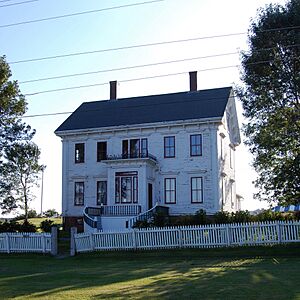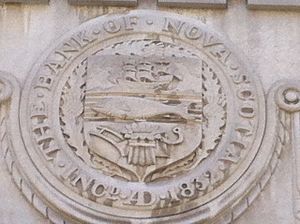William Dawson Lawrence facts for kids
Quick facts for kids
William Dawson Lawrence
|
|
|---|---|

William D. Lawrence – Nova Scotia House of Assembly (1864)
|
|
| Born | 16 July 1817 Gilford, District of Banbridge, County Down, Northern Ireland
|
| Died | 8 December 1886 (aged 69) Maitland, Hants County, Nova Scotia
|
| Resting place | Oak Island Cemetery, Maitland, Hants County, Nova Scotia |
| Occupation | Shipbuilder, Businessman, Politician |
| Spouse(s) | Mary Hayes |
| Parent(s) | William Dawson Lawrence and Mary Jane Lockhart |
William Dawson Lawrence (born July 16, 1817 – died December 8, 1886) was a very successful shipbuilder, businessman, and politician from Nova Scotia, Canada. He is famous for building the William D. Lawrence. This ship was said to be the largest wooden sailing ship ever built in Canada.
In 1874, people believed the William D. Lawrence was the biggest wooden sailing ship in the whole world. Building this huge ship was the highlight of William D. Lawrence's career. He built it in Maitland, Hants County, Nova Scotia. The ship was an amazing 263 feet long!
A famous historian named Frederick William Wallace once wrote about how special this ship was. He said if it had been built anywhere else, people would have talked about Lawrence's skill everywhere. But it was built in a quiet Nova Scotia town.
Building Giant Ships
William D. Lawrence started his career building ships in Dartmouth, Nova Scotia. He designed his first ship there in 1849. He also learned from a great shipbuilder named Donald McKay in Boston.
After his studies, Lawrence came back to Nova Scotia. He built two ships near his childhood home. Later, he built six more ships at his own William D. Lawrence Shipyard in Maitland, Hants County, Nova Scotia. He was very good at business and made a lot of money.

The William D. Lawrence had an exciting first trip that lasted three years. It was first towed from Maitland to Saint John, New Brunswick. After getting ready there, it sailed to many places. These included Liverpool, England, Aden (in present-day Yemen), Callao, Peru, Le Havre, France, and St. John's, Newfoundland. Finally, it returned home.
During his voyages, Lawrence wrote down what life was like for sailors. He described catching a shark and other events at sea and in port.
Lawrence built eight ships in total, and they all made him a lot of money. His last two ships, the Pegasus (built in 1867) and the William D. Lawrence (built in 1874), were the most profitable. The Pegasus earned him $1.4 million in its first four years. The William D. Lawrence made $1 million in its first three years. After five more years, he sold the William D. Lawrence for $2.4 million, which was a huge profit!
A Career in Politics
William D. Lawrence also served as a politician. He was elected to the 23rd General Assembly of Nova Scotia in 1863. He represented Hants County, Nova Scotia. He ran on a promise that all Nova Scotians should have the right to vote, not just those who owned property.
Lawrence strongly believed in public education. He thought it was important for a healthy democracy. He joined Joseph Howe and the Anti-Confederation Party. They fought against Charles Tupper's plan for Nova Scotia to join Confederation. Confederation happened on July 1, 1867. However, Lawrence and other "Anti-Confederate" politicians won the next election in September 1867. Joseph Howe also won his election to the federal government.
Later, Joseph Howe changed his mind and supported Confederation. Lawrence continued to oppose it and lost the election in 1871. He then took a break from politics for seven years to build his great ship, the William D. Lawrence. He tried to run for office again in 1878 but was not chosen by his party.
Remembering William D. Lawrence
William D. Lawrence and his famous ship have been remembered in many ways. In 1930, the Bank of Nova Scotia put a stone carving of the ship above the door of their main office in Halifax, Nova Scotia.
In 1967, a monument for Lawrence's ship was placed at his home. His home then became a provincial museum in 1971. The ship has also been honored by Canada Post with a postage stamp in 1975. The Royal Canadian Mint also put it on a coin in 2002.
Many paintings of the ship exist. One painting by E. Petit hangs in Government House (Nova Scotia). The most famous painting is by Edouard-Marie Adam. It is kept in the Musée national de la Marine in Paris, France.


